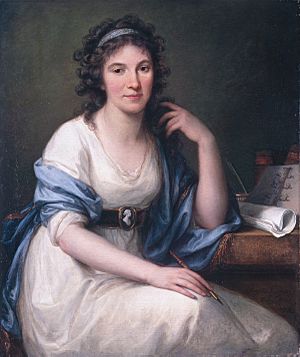Cornelia Knight facts for kids
Ellis Cornelia Knight (born March 27, 1757 – died December 18, 1837) was an amazing English woman. She was a traveler, an artist, and a writer. She wrote novels, poems, journals, and even history books.
Cornelia met many famous people during her life. When she was young, she knew people like Samuel Johnson and Sir Joshua Reynolds. Later, while living in Italy, she met important figures like Sir William and Lady Emma Hamilton, and the famous naval hero Lord Horatio Nelson. She also worked for the British Royal Family, serving Queen Charlotte and Princess Charlotte Augusta of Wales. She even corresponded with other writers like Frances Burney.
Contents
Ellis Cornelia Knight's Early Life and Travels
Cornelia Knight's father was Sir Joseph Knight. He was a Royal Navy officer who became a Rear Admiral. Her mother, Philippina Deane, was his second wife. Cornelia received a very good education. She even learned to dance from a famous teacher named Augustin Noverre.
When her father passed away in 1775, Cornelia and her mother had very little money. Because of this, they decided to move to Italy in 1776. They settled there and lived for many years.
Becoming a Published Author
In 1790, Cornelia published her first novel, Dinarbas. She didn't use her real name at first. This book was a follow-up to a famous story called Rasselas by Samuel Johnson. In Cornelia's version, Rasselas becomes a happy ruler.
After Dinarbas was successful, she published another book in 1792. It was called Marcus Flaminius. This was a historical novel told through letters.
Meeting Famous Figures in Italy
In 1798, Cornelia and her mother were living in Naples, Italy. They heard the exciting news of Lord Nelson's big victory at the Battle of the Nile. When Nelson arrived in Naples, everyone celebrated. Cornelia and her mother became good friends with the Hamiltons and Lord Nelson.
After her mother died in 1799, Cornelia was invited to travel back to England with the Hamiltons and Lord Nelson. During this trip, she saw how close Lady Hamilton and Lord Nelson were. She also heard Lady Emma sing a special song about Nelson's victory, set to music by Joseph Haydn.
Working for the Royal Family
Once back in England, Cornelia lived on her own. She continued to write and often visited her friends. In 1805, she was asked to join the household of Queen Charlotte. This was because she was known as a smart and respected writer.
Cornelia stayed with the Queen as the King's health declined. Later, in 1812, she became a companion to Princess Charlotte Augusta of Wales. She held this job until 1814. The Regent, who was ruling for the King, let her go due to some misunderstandings.
Later Life and Legacy
In 1818, Cornelia became a teacher. She taught English, literature, science, and art to a young man named Massimo Taparelli. He later became an important Italian writer, painter, and politician. He even mentioned Cornelia in his own memoirs.
Cornelia spent the last twenty years of her life outside of England. She passed away in Paris, France.
Ellis Cornelia Knight's Published Works
Cornelia Knight published five main works during her lifetime:
- Dinarbas (1790): This was a continuation of Samuel Johnson's famous story, Rasselas.
- Marcus Flaminius: a view of the military, political, and social life of the Romans in a series of letters from a patrician to his friend (1792): A romantic novel set in ancient Rome. It tells a story through letters.
- A Description of Latium, or La Campagna di Roma (1805): This book included her own drawings.
- Translations from the German in Prose and Verse (1812): A collection of her translations.
- Sir Guy de Lusignan, a Romance (1833): Another one of her novels.
When she died, Cornelia left behind an unfinished autobiography and a journal. Her autobiography is a very important source of information. It helps us understand what court life was like during her time. The most important parts of her autobiography were published after her death in 1861.


